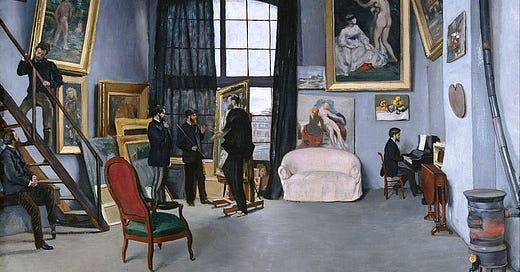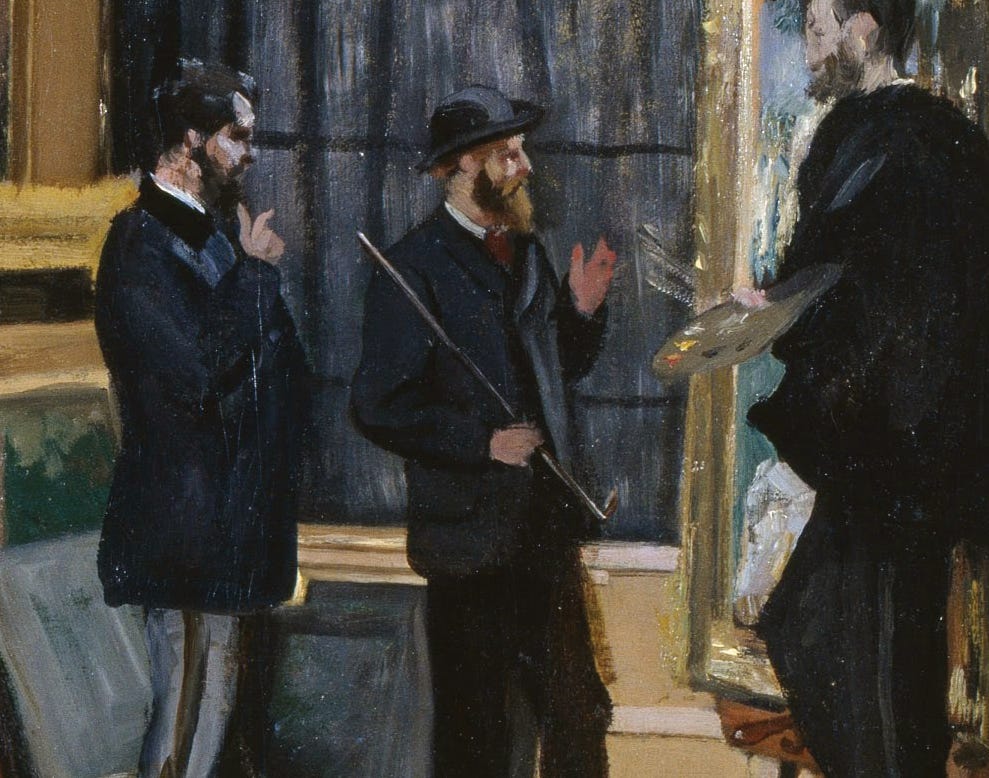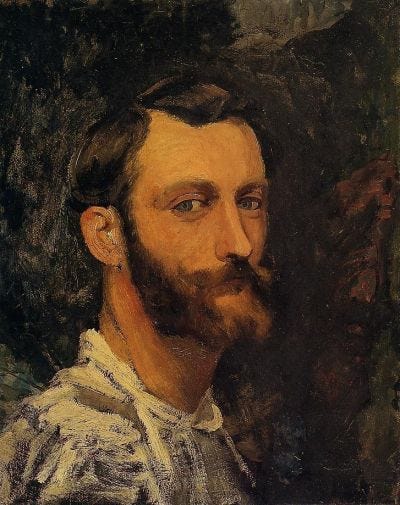Offering us a behind the scenes look into the studio that was something of a home away from home for many of the most famous Impressionists in their early career.
Jean Frédéric Bazille completed this work in early 1870 - only a few months before setting off with the French army to fight in the Franco-Prussian War.
He was twenty eight years old at the time - and, sadly, would not live to see his twenty ninth birthday, due to being fatally wounded on the field at the Battle of Beaune-la-Rolande.
Thus, the painting we are looking at to day may have started as a “portrait of an artist studio”. But, over time, it has taken on a whole new level of poignancy too.
Of course, at the time of painting, Bazille would never have imagined that this would become almost like his own memorial piece.
In fact, he painted it much more as a simple tribute to friendship . . . capturing a relatively casual afternoon where he and his friends had gathered at his Paris Studio (as they so often did) to discuss art and life together.
_
Bazille is the man we see just off centre - by far, the tallest figure in the room.
And the studio we are situated in actually belongs to him; though he was generous enough to share this space rent free with his friends too (many of whom were not fortunate enough to come from a wealthy family, as Bazille had)
In fact, at the time of painting, we could go as far as to say that Bazille was something of the leading figure in this band of artists who would one day be known as “The Impressionists”.
After all, it was Bazille who so often supplied the paints and the canvases that his friends could not afford.
It was Bazille who provided ongoing encouragement and emotional support, despite being one of the youngest among them.
And it was Bazille who first suggested to his friends that, one day, perhaps they should organise their own art exhibition - if only to shake up the traditional art world at the time.
_
So, while he was sadly destined never to see that idea actually come to fruition . . . it is no exaggeration to say that the legendary “Impressionist exhibition” of the 1874 may never have happened at all if it were not for Bazille’s influence more than 5 years earlier.
But as you might have also guessed by now, Frederic Bazille is not the only recognisable artist in attendance at our studio scene here today.
To the left hand side - standing on the staircase - is Pierre-Auguste Renoir . . . arguably Bazille’s closest friend of all, and a man who, at the time of this painting, had been sharing this studio full time for the best part of 2 years.
The two men were the same age - first meeting in 1862, when they were art students under the guidance of Charles Gleyre.
And in fact, it was at the studio of Charles Gleyre that Bazille and Renoir would befriend two other ambitious young artists too - Claude Monet, and Alfred Sisley . . . both of whom, are also to be found present in our studio here today.
Admittedly, historians do still disagree at times over exactly who is who.
But, comparing the features of each men with prior photos / portraiture - it is likely that the man sitting under the staircase is Monet, while Sisley is the man standing towards the centre of the composition,
Then, directly next to Sisley - wearing that rather fetching bowler hat - is one more artist I am sure some of you will recognise.
Edouard Manet. A man who was a few years older than his other friends - but who had already caused his own fair share of controversy in the Parisian art world with the release of such “scandalous” works as “Olympia” and “Le Déjeuner sur l'herb”
So, suffice to say - Frederic Bazille certainly knew how to keep good company!
And the only other man we have not mentioned yet is the writer Edmond Maitre - a key supporter of the Impressionists, who can be found over to the far right of our picture, tinkling away at a piano.
But it’s also worth taking a quite moment to notice the paintings that Bazille has chosen to decorate the walls with too
Here, we can identify known works by Monet, Renoir and Bazille himself. But, we also find an autumnal landscape from Camille Pissarro, and a still life piece from Paul Cezanne . . . once again, suggesting the presence of a few more close friends, even if they could not be in attendance physically on this particular studio day!
So, with all that in mind, it really is rather moving to see the care our artist has taken to include all of his friends (in one form or another) in his studio picture.
And again, gives us a wonderful insight to Bazille’s endearing character.
Essentially, he is painting this work as a show of solidarity - telling his friends that while they may be scorned, rejected, or mocked by so many others in the established art world . . . here in this studio, their work took pride of place. And, further still, he is showing them that their friendship means even more to him!
After all, an artist’s studio is often seen a sacred space - i.e a place to retreat from the world, or to focus exclusively on a very individual vocation.
Yet, for Bazille, it was quite the opposite. Hence, he wants us to be in no doubt at all that his own studio - and his own life as an artist - would be nothing without the treasured company of his friends.
All support is immensely appreciated













Wonderful story. Thank you. So good to see an analysis of Impressionist art based on personality rather than an endless repeat of the "quick, visible brushstrokes, effects of light" narrative.
Thank you for sharing this painting and this story! It's such a great display of the role of community in developing an art movement. Like the Pre-Raphaelite Brotherhood, Impressionism would not have been possible in a vacuum, it depended on human relationships.